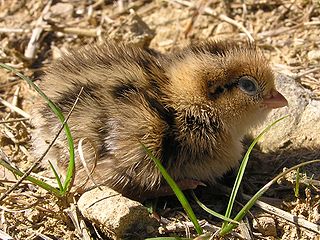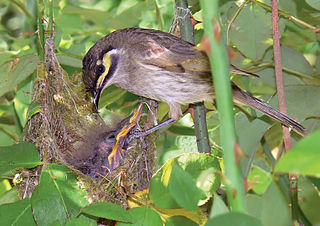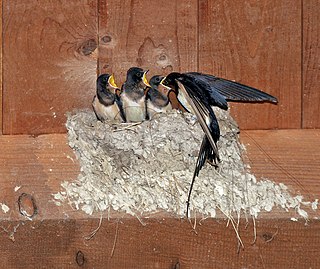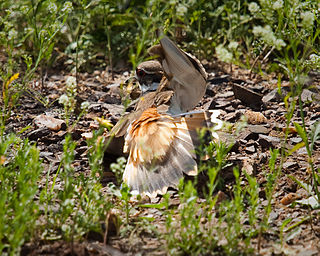
Birth is the act or process of bearing or bringing forth offspring, also referred to in technical contexts as parturition. In mammals, the process is initiated by hormones which cause the muscular walls of the uterus to contract, expelling the fetus at a developmental stage when it is ready to feed and breathe.

The megapodes, also known as incubator birds or mound-builders, are stocky, medium-large, chicken-like birds with small heads and large feet in the family Megapodiidae. Their name literally means "large foot" and is a reference to the heavy legs and feet typical of these terrestrial birds. All are browsers, and all but the malleefowl occupy wooded habitats. Most are brown or black in color. Megapodes are superprecocial, hatching from their eggs in the most mature condition of any bird. They hatch with open eyes, bodily coordination and strength, full wing feathers, and downy body feathers, and are able to run, pursue prey, and in some species, fly on the same day they hatch.

Fledging is the stage in a flying animal's life between hatching or birth and becoming capable of flight. This term is most frequently applied to birds, but is also used for bats. For altricial birds, those that spend more time in vulnerable condition in the nest, the nestling and fledging stage can be the same. For precocial birds, those that develop and leave the nest quickly, a short nestling stage precedes a longer fledging stage.

In biology, precocial species are those in which the young are relatively mature and mobile from the moment of birth or hatching. The opposite developmental strategy is called altricial, under which the young are born or hatched helpless. These categories form a continuum, without distinct gaps between them. Precocial species are normally nidifugous, meaning that they leave the nest shortly after birth or hatching.

The olive baboon, also called the Anubis baboon, is a member of the family Cercopithecidae Old World monkeys. The species is the most wide-ranging of all baboons, being native to 25 countries throughout Africa, extending from Mali eastward to Ethiopia and Tanzania. Isolated populations are also present in some mountainous regions of the Sahara. It inhabits savannahs, steppes, and forests. The common name is derived from its coat colour, which is a shade of green-grey at a distance. A variety of communications, vocal and non-vocal, facilitate a complex social structure.
Nidifugous organisms are those that leave the nest shortly after hatching or birth. The term is derived from Latin nidus for "nest" and fugere, meaning "to flee". The terminology is most often used to describe birds and was introduced by Lorenz Oken in 1816. The chicks of birds in many families, such as the waders, waterfowl, and gamebirds, are usually nidifugous.

In oviparous biology, a hatchling is a newly hatched fish, amphibian, reptile, or bird. A group of mammals called monotremes lay eggs, and their young are hatchlings as well.

Parental investment, in evolutionary biology and evolutionary psychology, is any parental expenditure that benefits offspring. Parental investment may be performed by both males and females, females alone or males alone. Care can be provided at any stage of the offspring's life, from pre-natal to post-natal.

A litter is the live birth of multiple offspring at one time in animals from the same mother and usually from one set of parents, particularly from three to eight offspring. The word is most often used for the offspring of mammals, but can be used for any animal that gives birth to multiple young. In comparison, a group of eggs and the offspring that hatch from them are frequently called a clutch, while young birds are often called a brood. Animals from the same litter are referred to as litter-mates.

The wedge-capped capuchin or Guiananweeper capuchin is a capuchin monkey from South America. It is found in northern Brazil, Guyana and Venezuela. The genus Cebus is divided into several different species. However, taxonomists argue over the specific divisions within the genus, which are uncertain and controversial. Cebus olivaceus is known to dwell in tall, primary forest and travel over long distances during the day.

The Tiliqua scincoides scincoides, or eastern blue-tongued lizard, is native to Australia. It is unique due to its blue tongue, which can be used to warn off predators. In addition to flashing its blue tongue, the skink hisses and puffs up its chest to assert dominance and appear bigger when in the presence of its predators such as large snakes and birds. The eastern blue tongue is ovoviviparous and precocial, meaning that its young are more developed and advanced at their time of birth. The Tiliqua scincoides scincoides is not poisonous to humans and can be found in suburban and urban areas, specifically in house gardens.

The mountain weasel, also known as the pale weasel, Altai weasel or solongoi, primarily lives in high-altitude environments, as well as rocky tundra and grassy woodlands. This weasel rests in rock crevices, tree trunks, and abandoned burrows of other animals or the animals it previously hunted. The home range size of this animal is currently unknown. Geographical distribution for this species lies in parts of Asia from Kazakhstan, Tibet, and the Himalayas to Mongolia, northeastern China, and southern Siberia. The most common area for this species, however, is Ladakh, India. The conservation status, according to the IUCN, is near threatened because it is considered to be in significant decline and requires monitoring mainly because of habitat and resource loss.
Cooperative breeding is a social system characterized by alloparental care: offspring receive care not only from their parents, but also from additional group members, often called helpers. Cooperative breeding encompasses a wide variety of group structures, from a breeding pair with helpers that are offspring from a previous season, to groups with multiple breeding males and females (polygynandry) and helpers that are the adult offspring of some but not all of the breeders in the group, to groups in which helpers sometimes achieve co-breeding status by producing their own offspring as part of the group's brood. Cooperative breeding occurs across taxonomic groups including birds, mammals, fish, and insects.

In animals, infanticide involves the killing of young offspring by a mature animal of the same species, and is studied in zoology, specifically in the field of ethology. Ovicide is the analogous destruction of eggs. The practice has been observed in many species throughout the animal kingdom, especially primates but including microscopic rotifers, insects, fish, amphibians, birds and mammals. Infanticide can be practiced by both males and females.

Parental care is a behavioural and evolutionary strategy adopted by some animals, involving a parental investment being made to the evolutionary fitness of offspring. Patterns of parental care are widespread and highly diverse across the animal kingdom. There is great variation in different animal groups in terms of how parents care for offspring, and the amount of resources invested by parents. For example, there may be considerable variation in the amount of care invested by each sex, where females may invest more in some species, males invest more in others, or investment may be shared equally. Numerous hypotheses have been proposed to describe this variation and patterns in parental care that exist between the sexes, as well as among species.
A nidicolous animal is an animal that stays at its birthplace for a long time because it depends on the parents for food, protection, and the learning of survival skills. They are the opposite of nidifugous species, which leave their parents more quickly and survive independently.
A fetus or foetus is the unborn offspring that develops from an animal embryo. Following embryonic development the fetal stage of development takes place. In human prenatal development, fetal development begins from the ninth week after fertilisation and continues until birth. Prenatal development is a continuum, with no clear defining feature distinguishing an embryo from a fetus. However, a fetus is characterized by the presence of all the major body organs, though they will not yet be fully developed and functional and some not yet situated in their final anatomical location.

Distraction displays, also known as diversionary displays, or paratrepsis are anti-predator behaviors used to attract the attention of an enemy away from something, typically the nest or young, that is being protected by a parent. Distraction displays are sometimes classified more generically under "nest protection behaviors" along with aggressive displays such as mobbing. These displays have been studied most extensively in bird species, but also have been documented in populations of stickleback fish and in some mammal species.
Vertebrate maternal behavior is a form of parental care that is specifically given to young animals by their mother in order to ensure the survival of the young. Parental care is a form of altruism, which means that the behaviors involved often require a sacrifice that could put their own survival at risk. This encompasses behaviors that aid in the evolutionary success of the offspring and parental investment, which is a measure of expenditure exerted by the parent in an attempt to provide evolutionary benefits to the offspring. Therefore, it is a measure of the benefits versus costs of engaging in the parental behaviors. Behaviors commonly exhibited by the maternal parent include feeding, either by lactating or gathering food, grooming young, and keeping the young warm. Another important aspect of parental care is whether the care is provided to the offspring by each parent in a relatively equal manner, or whether it is provided predominantly or entirely by one parent. There are several species that exhibit biparental care, where behaviors and/or investment in the offspring is divided equally amongst the parents. This parenting strategy is common in birds. However, even in species who exhibit biparental care, the maternal role is essential since the females are responsible for the incubation and/or delivery of the young.















